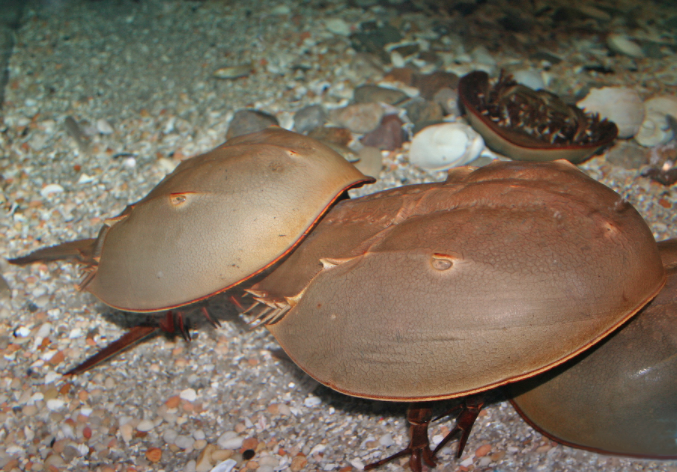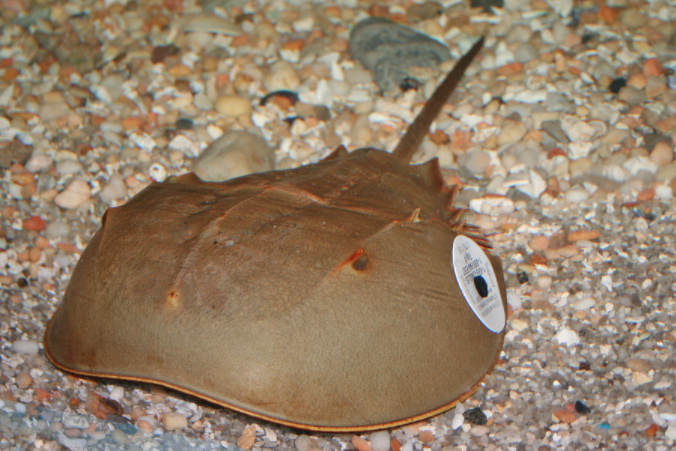It’s not the spring-break craziness of Daytona, Cancún or South Padre Island, but one of nature’s oldest annual beach mating rituals is about to resume at Calf Pasture Beach in Norwalk, and The Maritime Aquarium at Norwalk needs help documenting it.
During the new and full moons each spring, horseshoe crabs come up out of Long Island Sound to spawn in the sand. For researchers working on a horseshoe crab census, that’s a tagging bonanza time — so much so that citizen-scientist volunteers are needed.
To help out, volunteers first must attend a training session at The Maritime Aquarium: The first one was last Wednesday, but there’s another one scheduled for 7 p.m., Sunday, May 21.

Photo from Maritime Aquarium
Horseshoe crabs
They’ll learn about the natural history of horseshoe crabs, what has been learned so far from the census work, and how to harmlessly tag the crabs. Volunteers should be in 10th grade or older. Younger children can assist if working with a parent, teacher or guardian. (If you’ve helped tag crabs before, you don’t have to attend the trainings.)
Volunteers also must be able to be out after midnight for the crab-tagging sessions at Calf Pasture Beach in Norwalk on the nights of May 25, June 9 and June 23.
“The tagging sessions are the best kind of ‘citizen scientist’ opportunity: you’re out there with us doing real data-collecting field work; it’s maybe a little mucky; maybe a little buggy; but it’s also fun and you’re helping to accomplish something important,” said Aquarium spokesman Dave Sigworth. “The crab taggings are an especially great experience for teen-agers interested in a career in marine biology.”
The taggings are part of an ongoing census of horseshoe crabs in Long Island Sound being led by Dr. Jennifer Mattei of Sacred Heart University in Fairfield. The Maritime Aquarium is assisting with the census and tagging.

Photo from Maritime Aquarium
As someone from the Maritime Aquarium said: “’Ah spring, when a young horseshoe crab’s fancy lightly turns to thoughts of love.’ That’s the correct Tennyson quote, right?”
Dr. Mattei’s census is helping to confirm that the horseshoe crab population in the Sound is notably down. That’s not good, because horseshoe crab eggs are an important food source for migrating shorebirds. Having fewer crab eggs to eat makes life harder for the birds.
Survivors from the Paleozoic Era — and looking every bit the part — horseshoe crabs are commercially harvested for bait and for use in the pharmaceutical industry. (A derivative from the crabs’ blood is used in medical testing. Crabs are returned to the water after their blood is drawn, but not all crabs survive.)
The Atlantic States Marine Fisheries Commission has established quotas on how many crabs can be harvested from each state. In Connecticut, the Department of Energy & Environmental Protection set limits on when, where and how the crabs can be harvested, in an effort to stabilize and restore the population.
To sign up or for more details about the trainings and taggings, call The Maritime Aquarium at (203) 852-0700, ext. 2281, or e-mail bcervero@maritimeaquarium.org. If you’ve helped tag horseshoe crabs before, you don’t need to attend one of the trainings. But please call or send an email to sign up for one of the tagging sessions at Calf Pasture.
